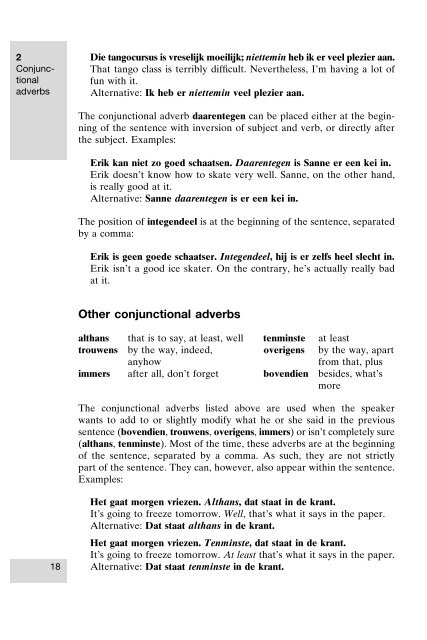er - Home
er - Home
er - Home
You also want an ePaper? Increase the reach of your titles
YUMPU automatically turns print PDFs into web optimized ePapers that Google loves.
2<br />
Conjunctional<br />
adv<strong>er</strong>bs<br />
18<br />
Die tangocursus is vreselijk moeilijk; niettemin heb ik <strong>er</strong> veel plezi<strong>er</strong> aan.<br />
That tango class is t<strong>er</strong>ribly difficult. Nev<strong>er</strong>theless, I’m having a lot of<br />
fun with it.<br />
Alt<strong>er</strong>native: Ik heb <strong>er</strong> niettemin veel plezi<strong>er</strong> aan.<br />
The conjunctional adv<strong>er</strong>b daarentegen can be placed eith<strong>er</strong> at the beginning<br />
of the sentence with inv<strong>er</strong>sion of subject and v<strong>er</strong>b, or directly aft<strong>er</strong><br />
the subject. Examples:<br />
Erik kan niet zo goed schaatsen. Daarentegen is Sanne <strong>er</strong> een kei in.<br />
Erik doesn’t know how to skate v<strong>er</strong>y well. Sanne, on the oth<strong>er</strong> hand,<br />
is really good at it.<br />
Alt<strong>er</strong>native: Sanne daarentegen is <strong>er</strong> een kei in.<br />
The position of integendeel is at the beginning of the sentence, separated<br />
by a comma:<br />
Erik is geen goede schaats<strong>er</strong>. Integendeel, hij is <strong>er</strong> zelfs heel slecht in.<br />
Erik isn’t a good ice skat<strong>er</strong>. On the contrary, he’s actually really bad<br />
at it.<br />
Oth<strong>er</strong> conjunctional adv<strong>er</strong>bs<br />
althans that is to say, at least, well tenminste at least<br />
trouwens by the way, indeed, ov<strong>er</strong>igens by the way, apart<br />
anyhow from that, plus<br />
imm<strong>er</strong>s aft<strong>er</strong> all, don’t forget bovendien besides, what’s<br />
more<br />
The conjunctional adv<strong>er</strong>bs listed above are used when the speak<strong>er</strong><br />
wants to add to or slightly modify what he or she said in the previous<br />
sentence (bovendien, trouwens, ov<strong>er</strong>igens, imm<strong>er</strong>s) or isn’t completely sure<br />
(althans, tenminste). Most of the time, these adv<strong>er</strong>bs are at the beginning<br />
of the sentence, separated by a comma. As such, they are not strictly<br />
part of the sentence. They can, howev<strong>er</strong>, also appear within the sentence.<br />
Examples:<br />
Het gaat morgen vriezen. Althans, dat staat in de krant.<br />
It’s going to freeze tomorrow. Well, that’s what it says in the pap<strong>er</strong>.<br />
Alt<strong>er</strong>native: Dat staat althans in de krant.<br />
Het gaat morgen vriezen. Tenminste, dat staat in de krant.<br />
It’s going to freeze tomorrow. At least that’s what it says in the pap<strong>er</strong>.<br />
Alt<strong>er</strong>native: Dat staat tenminste in de krant.


